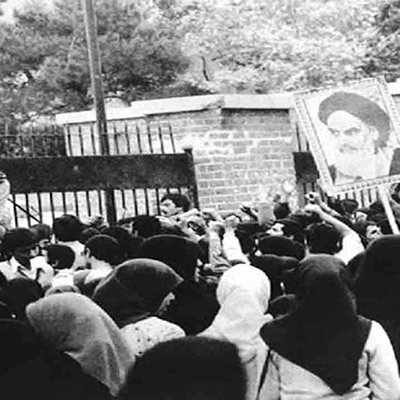Groups, Institutions, Organiza
The Muslim Student Followers of the Imam’s Line
Marzieh Abedini
180 دورہ
Several students who were part of the Office for Strengthening Unity (Daftar-e Tahkim-e Vahdat), and became known as the Muslim Student Followers of the Imam’s Line after seizing the U.S. Embassy on November 4, 1979, also took part in the Iran–Iraq War. Given the critical situation in several parts of the country, members of the Islamic associations of universities, including National University (Shahid Beheshti), University of Tehran, Polytechnic University (Amir-Kabir), and Sharif University of Technology, held a meeting in March 1979. They agreed that during the upcoming Nowruz holidays, a team from the Islamic student associations would travel to a conflict-affected area to directly observe the problems and explore possible solutions. After holding multiple sessions, it was decided to establish an organization focused on social, welfare and construction work in such areas. Then, following the consultations with the Provisional Government of the Islamic Revolution and the approval of Imam Khomeini (ra), this initiative led to the formation of the Jahad-e Sazandegi Organinzation.
Motivated by the same revolutionary ideals, many members of the Islamic associations joined the newly established institutions such as the Islamic Revolutionary Guard Corps (IRGC) and the Jahad-e Daneshgahi. Later on, influenced by the discourse of the Islamic Revolution, they came up with the idea of forming a countrywide structure to unite Islamic student groups and supporters of Imam Khomeini (ra) to help push his ideas and the revolutionary values more strongly on campus.
In the summer of 1979, representatives from the Islamic student associations of the University of Tehran, National University, Sharif University of Technology, Polytechnic University, and Iran University of Science and Technology held joint meetings in which they agreed to form a national organization. During a meeting with Imam Khomeini (ra), they presented their idea, to which he replied: “Try to strengthen the unity”.[1] The name “Tahkim-e Vahdat” (Strengthening Unity) was thus derived from his words. One of the first major actions of the Office for Strengthening Unity was the seizure of the U.S. Embassy in Tehran on November 4, 1979.[2]
Before the Islamic Revolution, Muslim students of Tehran’s universities knew each other as they had been involved in political activities. Some of them were also familiar with Hojatoleslam Seyyed Muhammad Mousavi Khoeiniha, who served as the Prayer Leader of Jowestan Mosque in Niavaran, Tehran. He was recognized as a cleric closely tied to Imam Khomeini (ra) and the Revolution. The students talked to him about their plan to take over the U.S. Embassy, trying to get a sense of how Imam Khomeini (ra) might feel about it. However, Mousavi Khoeiniha did not believe it was necessary to consult Imam Khomeini (ra) before the action.
These students were primarily from the four main universities of Tehran, namely Sharif University of Technology, National University, University of Tehran, and Polytechnic University.[3] About 400 students took part in the occupation, with an average age of 22, and a quarter of them were women.[4]
The United States admitted the deposed Shah of Iran on October 22, 1979, for medical treatment.[5] In response, Imam Khomeini (ra), on November 1, 1979, stated on the anniversary of the brutal attack on the Tehran University by the Pahlavi regime (November 4, 1978): “It is for the university and high school students, university staff and those learning religious sciences to demonstrate their power against America and Israel and force them to expel and handover the ousted and criminal Shah to once again strongly denounce this grave plot”.[6]
On the anniversary of Imam Khomeini’s exile to Turkey and the first anniversary of the killing of students at Tehran University by the Shah’s army, a group of Tehran residents went on a march. A number of student protesters began marching from Ayatollah Taleqani Street towards Tehran University. The protestors wanted to gather on the Tehran University campus; however, along the way, a small group of them broke off and climbed over the walls of the U.S. Embassy, opening the gates to allow other members in. To make their identity and purpose clear, the students hung a banner on the embassy’s front gate reading: “We, the Muslim Student Followers of the Imam’s Line, have occupied the American Embassy to protest against the crimes of the U.S., especially its decision to host the deposed Shah”.[7]
Later that same afternoon, the students held a press conference attended by local and international journalists, formally introducing themselves as the Muslim Student Followers of the Imam’s Line.[8]
On November 5, 1979, Imam Khomeini (ra) gave a speech in which he expressed support for the students’ action in seizing the U.S. Embassy.[9]
Within the organizational structure of the Muslim Student Followers of the Imam’s Line, a decision-making council was formed. It included five representatives from the four universities involved in the embassy takeover, along with Hojatoleslam Muhammad Mousavi Khoeiniha. Also, it had six specialized committees. Operations Committee would provide the security inside the embassy; Documents Committee was tasked with translating, restoring, and publishing recovered documents; Public Relations Committee was responsible for holding press conferences, interviews, and meetings with officials; Services Committee was providing food and essential supplies; Intelligence Committee oversaw security and intelligence; and Hostage Affairs Committee would deal with all matters related to the hostages.[10]
The students demanded the extradition of the Shah and the return of his confiscated assets to Iran. As the months passed, and the U.S. Embassy—renamed the “Den of Espionage”—remained occupied, President Carter’s administration failed to secure the release of the hostages. Even after the election of Abolhassan Banisadr as the first president of the Islamic Republic, no significant progress was made on the hostage issue. Nonetheless, the Americans hoped that they could resolve the issue without conceding to Iran’s demands.
On April 24, 1980, the U.S. launched Operation Eagle Claw, a mission by Delta Force, America’s premier counterterrorism unit, to rescue the hostages via Iran’s southern deserts. The operation ended in disaster due to a sandstorm, which caused mechanical failure and a collision between aircraft, killing eight Delta Force personnel and leading to the mission’s failure. Later that summer, one of the hostages tried to escape but was unsuccessful. In response to these incidents, the students, in coordination with the Islamic Revolutionary Guard Corps (IRGC), divided the hostages into smaller groups and transferred them to different cities across Iran.
On September 12, 1980, Imam Khomeini (ra) outlined four preconditions for the release of the American hostages, including the return of the Shah’s wealth to Iran, cancellation of all U.S. claims against Iran, the U.S. pledge not to interfere in Iran’s internal political or military affairs, and unfreezing Iran’s financial assets.
Members of the first Islamic Consultative Assembly were tasked with overseeing the hostage situation. Ultimately, they asked the government to continue the negotiations on the hostage issues.
On September 22, 1980, Iraq launched a full-scale invasion of Iran. With the outbreak of war, many of the students involved in the embassy takeover left for the frontlines.
On January 19, 1981, the Algiers Accords were signed between Iran and the United States and January 21st was set as the official date for the hostages’ release. Escorted by the Muslim Student Followers of the Imam’s Line, the 52 hostages were transported by bus to the airport and handed over to Algerian authorities. After 444 days, at 9:00 PM on January 21, 1981, the seizure of the U.S. Embassy in Tehran finally ended, and all 52 American hostages were released.[11]
Following the resolution of the hostage issue, the students held a meeting to decide whether to form a political party or dissolve the Muslim Student Followers of the Imam’s Line Organization. The majority favored dissolution and the final statement indicated: “We should rejoin the people in the battlefronts, in rebuilding the country, and in the classrooms... From the beginning, we were the children of this nation and never apart from it. We have fulfilled our duty and now we are going back to help the people”.[12]
The “Den of Espionage” (former U.S. Embassy) remained under student control for several more years as documents review continued. In 1985, the government officially handed over control of the site to the IRGC.[13] Many members of the Muslim Student Followers of the Imam’s Line went on to join organizations such as the Jahad-e Sazandegi and the IRGC, playing active roles in the Iran–Iraq War. Mahdi Rajab-Beigi, Mohsen Vezvaei, Abbas Varamini, and Hussain Alamolhoda, who had all participated in the embassy takeover, were martyred during the war.[14]
To commemorate this chapter of Iran’s history, November 4, 1979, the anniversary of the U.S. Embassy takeover, was officially named the National Day of Fighting against Global Arrogance and the Student Day on Iran’s official calendar.[15]
[1] Kalantari, Abdolhussain, Daftar-e Tahkim-e Vahdat dar Keshakeshe Sonat va Tajaddod (Tahkim-e Vahdat in the Tension between Tradition and Modernity), Tehran, Markaze Asnade Enqelab-e Eslami, 1390, Pp. 172, 175, 176.
[2] Kordi, Ali, Daftar-e Tahkim-e Vahdat az Aghaz ta Ensheaab (Tahkim-e Vahdat from Inception to Dissolution), Tehran, Moassese Farhangi Honari Markaze Asnade Enqelab-e Eslami, 1390, Pp. 35, 70, 71.
[3] Pouryazdanparast, Muhammad-Hashem, Rooze Khoda – Barrasiye Elal va Khaterate Nakhostin Roozhaye Taskhire Lanei-e Jasousi (God’s Day – Examining Causes and Memories of the First Days of Embassy Takeover), Tehran, Entesharate Soore Mehr, 1390, p. 37.
[4] Bari, Rubin, Jange Ghodratha Dar Iran (The Struggle of Powers in Iran), Trans. Mahmoud Mashreqi, Bijaa, Bitaa, Binaa, p. 218.
[5] Kalate Arabi, Javad, Dar Hayahooye Sokoot – Revayate Mostanadi az Zendegi-ye Daneshjooye Peyro Khate Emam va Rais-e Setade Lashkare 27 Muhammad Rasulullah Shahide Abbas Varamini (Amid the Silence – A Documentary Narrative of Abbas Varamini’s Life), Tehran, Markaze Motaleat-e Pajoheshiye 27 Besat, 1397, p. 56.
[6] Moassese Tanzim va Nashre Asar-e Emam Khomeini, Sahifeh-ye Emam (An Anthology of Imam Khomeini’s Speeches, Messages, Interviews, Decrees, Religious Permissions, and Letters), Vol. 10, Tehran, Moassese Tanzim va Nashre Asar-e Emam Khomeini, 1378, p. 412.
[7] Pouryazdanparast, Muhammad-Hashem, Ibid., p. 39; Kalate Arabi, Javad, Ibid., Pp. 56, 57.
[8] Kalate Arabi, Javad, Ibid., p. 57.
[9] Moassese Tanzim va Nashre Asar-e Emam Khomeini, Ibid., p. 491.
[10] Ebtekar, Masoumeh, Taskhir – Avalin Revayate Maktoub az Daroon-e Sefarate Taskhirshode-ye Amrika dar Tehran (Embassy Takeover – The First Written Account from Inside the Occupied U.S. Embassy), Tehran, Ettelaat, 2nd ed., 1387, Pp. 268, 269.
[11] Kalate Arabi, Javad, Ibid., Pp. 90–93, 100, 101; Moassese Tanzim va Nashre Asar-e Emam Khomeini, Ibid., Vol. 13, 1378, p. 213.
[12] Ebtekar, Masoumeh, Ibid., p. 325; Kalate Arabi, Javad, Ibid., p. 101.
[13] Kalate Arabi, Javad, Ibid., p. 102.
[14] Ebtekar, Masoumeh, Ibid., p. 338.
[15] Enqelabe Dovom – Negahi be Taskhire Lanei-e Jasousi dar Sizdahome Abanmahe 1358 (The Second Revolution – A Look at the Embassy Takeover on Nov. 4, 1979), Tehran, Ketabe Sabz, 2nd ed., 1394, p. 13.





